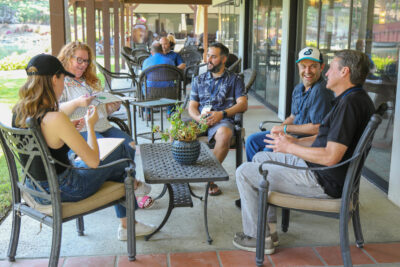
Seth Godin’s Top 5 Church Growth Principles
While Seth Godin doesn’t write directly to churches or pastors, he’s written the playbook on how ideas spread in the modern age.
Leaders Are Readers
Most of us have heard some variation of the quote “Leaders are readers”—affirming the age-old axiom that if it’s short and rhymes, it must be true. Still, it’s a sentiment most of us believe in. Learning is one of the most critical elements of growth. Whether that’s growth as a leader, as a person, or as a Christian, reading represents a willingness to take on new ideas, challenge old perceptions, and look to the future. It’s a vehicle not only for understanding and empathy, but also for spiritual growth and development.

Going Upstream
Every time I read a book, I find myself checking the footnotes and references because I want to know who that author read. I don’t just want to ingest that author’s ideas, I want to know how they came up with them: What books was this author reading when he or she wrote this book?
How did those ideas shape this book? It’s a reading principal I call “going upstream”—contextualizing yourself in the larger set of ideas and influences of an author in order to become more like them.
And when it comes to most modern thinking around church growth, there’s one name that’s on every author’s shelf: Seth Godin.
The Grandfather of Modern Marketing
Seth Godin isn’t just an important thinker in modern marketing: he’s literally written the book on why some ideas spread and others do not. You may not have read his book Tribes, but if you’ve read anything from Francis Chan, Carey Nieuwhof, Larry Osborne, or countless others who have written about leadership and church development, you’ve read more Seth Godin than you realize.
While Seth is a marketer and entrepreneur who doesn’t write directly to churches or pastors, he’s written the playbook that has formed modern thinking about how ideas spread in the modern age. That could be an idea as simple as starting a business that sells shoes, or an idea as important as sharing the Gospel with your community—he’s designed the engine that helps people in the 21st century share authentic and important ideas with the people who need to hear them most. So, whether you’re considering how to get people to attend a Christmas Eve service or designing your entire strategy for outreach to your community, Seth Godin is the author you need to be reading.
5 Ideas from Tribes Church Leaders Need to Hear Now
At the core of Tribes, Seth argues that the internet has ended the age of mass media. We’re no longer forced to get our news from just a few TV channels—we can go get it from any number of sources, some biased, some not. With mass media off the table, we’ve started to divide ourselves into groups of people.
Whether you lead a church plant of 50 people or a multisite church of 5,000, you belong to a tribe: a group of people rallied around a central idea. Those people are loyal. Devoted. Often, wary of other tribes. And there are central rules to how tribes—and their ideas—grow. Here’s five ideas from Tribes you need to hear now:
1. A tribe is a group of people connected to one another, a leader, and an idea
Tribes have three components—a group of people, connected around an idea, connected to a leader. There can be more than one leader, but there must be a central idea in order to be unified. In the context of your church, it’s mission critical that everyone is on the same page with you and your vision. Mission statements aren’t just a neat slogan to put on the website: they’re the fundamental backbone of your church.
2. Everyone belongs to more than one tribe
People (hopefully) don’t have to choose between being a part of your church and being a part of Crossfit (though who knows which they’ll talk about more on social media). Everyone belongs to more than one tribe—you can have both dog people and cat people at your church. While that may seem obvious, it’s important to ask what the major tribes are at your church. Maybe it’s a cohort of young families, or a yearly influx of college students. The first tribe may need more childcare at events or small groups that meet weeknights (because of work schedules), while the second tribe is attracted by a night service and a more authentic experience. Understanding the different tribes people are a part of is a key part of being there for their needs.
3. Human beings can’t help it: we need to belong
Everyone wants to belong somewhere—and your church’s tribe can be that place of belonging. That means setting clear and easy steps for getting involved, like simplifying how you can get involved serving or joining a small group.
4. Leaders who set out to give are more productive than leaders who seek to get
Leading your tribe is about being there for your tribe—plain and simple. And when people feel like they belong to your church, and your church cares for them, they become advocates for your church, bringing people into your tribe because they know you’ll take good care of them.
5. This isn’t about having a great idea (it almost never is)—the great ideas are already out there
Creativity is great, but not in every instance. It’s good to be creative about your outreach, but not so much in your doctrinal statement. The reality is that great ideas are great because of the execution behind them more so than their originality. And that’s doubly true for your church. You don’t always have to innovate. Sometimes you just need to hold the course, put in the work, and grow your tribe.
Seth Godin’s Best Piece of Advice
Seth Godin has a lot of valuable information to share about your church in Tribes—but it’s nothing compared to hearing him talk about how your church specifically can reach your community in profound ways.
Would that be worthwhile? Would it change anything to hear the godfather of modern marketing talk about how your church can reach more people?
Check out this video of Seth’s talk at our 2018 Summit conference!






